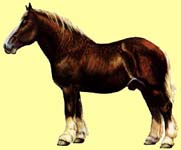|
|
The Muraközi(Murakosi, Murakoz, Murakozer) |
|
|
The Muraközi(Murakosi, Murakoz, Murakozer) |
| Group | Draft (Brachyomorphic) - Cold-blood |
|---|---|
| Influences |
|
| Characteristics |
|
| Colors |
|
| Odd Facts |
|

A draught horse, bred in the river Mura region of Hungary (and also in Poland and the former Yugoslav Republic), this breed has been developed during this century by crossing native mares with Percheron, Belgian Ardennes and Noriker stallions as well as with home-bred horses. In the 1920s a fifth of all horses in Hungary were Muraközis, but the breed suffered many losses in the Second World War and has not regained its former numbers. It is a fast-moving horse of some quality and is noted as being good-tempered, sound and an economical feeder. It is usually chestnut with flaxen mane and tail, but bays, browns, greys, and blacks do occur. The average height is 16 hh and the horse is a good agricultural worker. (Enc. Horse 1983)
Its strong frame has a pronounced dip in the back and powerful hindquarters. While the Muraközi's body is not massive or broad, it has sufficient depth through the girth. The back is short with a sloping and low-set tail; and its abdomen is tucked up. The Muraközi's quarters slope toward the dock of its tail, showing evidence of Oriental influence in the muscle structure length. Its legs are light, short, and well-built with good muscle and bone structure and the cannons and pasterns are short and have the correct slope. The leg joints are hard, its forearms muscular, and its gaskins (second-thighs) well-muscles and proportionate to its frame. Its hocks are positioned in line with the point of its buttocks. The medium-sized hoof is well-proportioned and rounded, appropriate for the breed's build.
While the Muraközi's future was looking bleak to some, it is far from becoming extinct. The Muraközi continues to be bred and used today in Hungary, Poland and in the countries that once made up Yugoslavia. During the 1970s nearly 85% of Hungary's poulation of 231,000 horses were employed for farming - and most of these were Muraközi. The breed was reestablished after World War II by importing 17 Ardennais stallion between 1947 and 1949 to rebuild the depeleted stock. The result was favorable for the Muraközi, which met with the demands which encouraged a regrowth in arable farming.
The Muraközi is noted for being efficient at converting food into energy, and is thus economical and important to an agricultural economy with minimal mechanization. This actile and versatile horse is well-suited to plowing and tilling of the medium type soil of the region. It matures early and it is possible to work it as a 2-year-old. Typical of most draft breeds, the Muraközi has a dependable physical constitution and a calm and even temperament. It does show the Arabian influences in its lighter, more elegant build without any addition of the hot temperament of the latter.
Originating in Hungary, this internationally important brachymorphic-type horse is now distributed in Poland and Yugoslavia, as well as Hungary. Developed during the course of the 20th Century in the region around the River Mura, this breed resulted from crossings of local Mur-Insulan mares with Belgian Ardennes, Percheron, Noriker, and native stallions Hungarian half-breds with Thoroughbred and/or Arabian blood). During the second World War, the Murakoz, also known as the Murakozer, suffered serious losses. It was then necessary to introduce new blood, this done by using Belgian Ardennes stallions. The Murakozer's name derives from the town of Murakoz in southern Hungary.
The Murakoz is bred in two versions, one being taller and heavier, and the other smaller and lighter. It is well suited to heavy farm work, and also has an aptitude for heavy draft. With a generally good conformation, it is robust with a compact, powerful build, which gives it great strength. This strong and frugal horse has a docile but energetic temperament. This swift moving drafter doesn't have the heavy feather of the Adrennais, though it did inherit some of the heavy frame as well as the equable temperament of the Ardennais.
Standing about 16 hand high at the withers, the Murakoz may be chestnut, bay, brown or grey. Chestnut horses tend to have lighter coloring in the mane, tail and leg feathering. The rather long and heavy head has a somewhat convex profile, long ears and gentle eyes. It has a short, muscular neck and low, broad withers. Its back is short, its croup sloping, and its tail set-on low. It has a wide, deep chest, the shoulder is sloping and powerful, and the abdomen tucked up. The short, well-built legs have good muscle and bone structure. Its cannons and pasterns are short and feathered, and its hooves are well-proportioned and rounded.
For more information, visit:

|
© 1997-2007
NW Breyer Horse Club & Refiner of Gold Creations Equinealities in place since 1997, Section in place 2001, Updated 3/13/2007 |



|
| ||

|
|||||